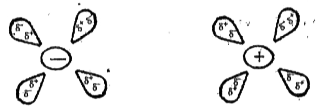Write notes on Intermolecular forces Solution in Telugu
Intermolecular forces:
a) .lon - Dipole forces": lon dipole forces are mainly important in aqueous solutions of ionic substances such as NaCl in which dipolar water molecules surround the ions.

Water molecules are polar and in them hydrogen atoms possess partial positive charges and oxygen atoms possess partial negative charges due to electronegativity difference between hydrogen and oxygen atoms. When ionic compounds like NaCl dissolve in water, they dissociate into component ions like Na+andCl−. Now the water molecules orient in the presence of ions in such a way that the positive end of the dipolé is near an anion and the riegative end of the dipole is near a cation.
b) Dipole-Dipole forces , Neutral but polar molecules experience dipole-dipole forces. These are due to the electrical interactions among dipoles on neighbouring molecules. These forces are again attractive between

unlike poles and repulsive between like poles and depend on the orientation of the molecules. The net force in a large collection of molecules results from many individual interactions of both types. The forces are generally weak and are significant only when the molecules are in close contact.
c) London dispersion forces : These forces result from the motion of electrons around atoms. Take, for example, atoms of helium. The electron distribution around a helium atom is for averaged over time spherically symmetrical. However, at a given instant the electron distribution in an atom may be unsymmetrical giving the atom a short-lived dipole moment. This instantaneous dipole on one atom can affect the electron distribution is neighbouring atoms and induce temporary dipoles in those neighbours. As a result, weak attractive forces develop known as London forces or dispersion forces. London forces are generally small. Their, energies are in the range 1 - 10k J mol−1.

d) Dipole - Induced Dipole forces : These forces are between polar molecules with permanent dipole moments and the molecules with no permanent dipole moment. Permanent dipole of the polar molecule induces dipole on the electrically neutral molecule by deforming into elec tronic cloud.
Magnitude of these forces depends on the magnitude of the dipole moment of permanent dipole and polarisatricity of neutral molecule. This interaction is proportional to(1r2) , where distance between molecules.
Topper's Solved these Questions
- STATES OF MATTER GASES AND LIQUIDS BOOK - VIKRAM PUBLICATION ( ANDHRA PUBLICATION)CHAPTER - STATES OF MATTER GASES AND LIQUIDS EXERCISE - SHORT ANSWER QUESTIONS
26 Videos
- ORGANIC CHEMISTRY SOME BASIC PRINCIPLES AND TECHNIQUES BOOK - VIKRAM PUBLICATION ( ANDHRA PUBLICATION)CHAPTER - ORGANIC CHEMISTRY SOME BASIC PRINCIPLES AND TECHNIQUES EXERCISE - IMPORTANT QUESTIONS
42 Videos
- STOICHIOMETRY BOOK - VIKRAM PUBLICATION ( ANDHRA PUBLICATION)CHAPTER - STOICHIOMETRY EXERCISE - Important Question
39 Videos
Similar Questions
State and explain Boyle's law.
View SolutionWrite the regents required for conversion of benzene to methyl benzene.
View SolutionHow many number of moles of glucose are present in 540 gms of glucose ?
View SolutionIntermolecular forces are
View SolutionWrite notes on Intermolecular forces
View SolutionINTERMOLECULAR FORCES
View SolutionIntermolecular Forces
View SolutionWrite a brief note on electromagnetic forces
View SolutionWrite a note on nuclear forces.
View SolutionWrite a detailed note on Coriolis Force.
View SolutionWrite a note on the intermolecular forces.
View SolutionExplain Dipole - Dipole forces snd its characteristics ?
View Solutionवह तापमान जहां अंतरआण्विक आकर्षण बल, अंतरआण्विक प्रतिकर्षण बल को संतुलित कर देता है, जाना जाता है:
View SolutionIntermolecular force.
View SolutionIntermolecular force is a ____.
View SolutionWrite note on the various intermolecular forces of attraction in molecular solids.
View Solution
